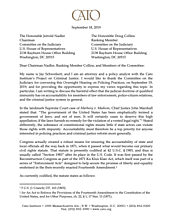In the landmark Supreme Court case of Marbury v. Madison, Chief Justice John Marshall stated that: “The government of the United States has been emphatically termed a government of laws, and not of men. It will certainly cease to deserve this high appellation, if the laws furnish no remedy for the violation of a vested legal right.”1 Stated differently, the substance of constitutional rights means little if state actors can violate those rights with impunity. Accountability must therefore be a top priority for anyone interested in policing practices and criminal justice reform more generally.
Congress actually created a robust means for ensuring the accountability of state and local officials all the way back in 1871, when it passed what would become our primary civil rights statute. That statute is presently codified at 42 U.S.C. § 1983, and thus is usually called “Section 1983” after its place in the U.S. Code. It was first passed by the Reconstruction Congress as part of the 1871 Ku Klux Klan Act, which itself was part of a series of “Enforcement Acts” designed to help secure the promise of liberty and equality enshrined in the then-recently enacted Fourteenth Amendment.2
As currently codified, the statute states as follows:


